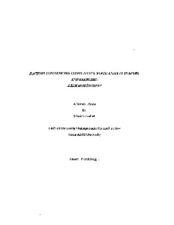| dc.contributor.advisor | LeUnes, Arnold | |
| dc.creator | Andres, Monica | |
| dc.date.accessioned | 2013-02-22T20:41:09Z | |
| dc.date.available | 2013-02-22T20:41:09Z | |
| dc.date.issued | 1998 | |
| dc.identifier.uri | https://hdl.handle.net/1969.1/ETD-TAMU-1998-Fellows-Thesis-A49 | |
| dc.description | Due to the character of the original source materials and the nature of batch digitization, quality control issues may be present in this document. Please report any quality issues you encounter to digital@library.tamu.edu, referencing the URI of the item. Digitized from print original stored in HDR | en |
| dc.description | Includes bibliographical references. | en |
| dc.description | Program year: 1997/1998 | en |
| dc.description.abstract | A meta-analysis was conducted across twenty-seven studies using the Competitive State Anxiety Inventory-2 (CSAI-2; Martens, Vealey, and Burton, 1990) administered to participants in both aerobic and anaerobic sports. The CSAI-2 assesses competitive state anxiety across the three component scales of somatic anxiety, cognitive anxiety and self-confidence. The twenty-seven studies provided CSAI-2 data that was compared to population norms to calculate effect sizes. Effects of five moderator variables (time, gender, type, level, and intensity) were examined. It was expected that anxiety would be greater the day before a competitive event, that women's anxiety scores would increase before a competitive event while men's scores would remain relatively stable, that those involved in interactive sports would have high lower anxiety scores as a result of social loafing, that high school participants would have higher anxiety scores than their elite counterparts as a result of lack of experience in handling anxiety, and that those involved in anaerobic sports would have greater anxiety scores because of multiple presentations of anxiety-inducing situations. General effects were found for type of exercise (coactive, interactive, mixed), intensity (aerobic versus anaerobic), and timing of data collection (related versus unrelated to performance). Hypotheses wereconfirmed through multivariate and univariate analysis conducted on effect sizes calculated with Cohen's d. | en |
| dc.format.medium | electronic | en |
| dc.format.mimetype | application/pdf | |
| dc.language.iso | en_US | |
| dc.rights | This thesis was part of a retrospective digitization project authorized by the Texas A&M University Libraries in 2008. Copyright remains vested with the author(s). It is the user's responsibility to secure permission from the copyright holder(s) for re-use of the work beyond the provision of Fair Use. | en |
| dc.subject | competitive state anxiety | en |
| dc.subject | aerobic sports | en |
| dc.subject | anaerobic sports | en |
| dc.subject | gender roles | en |
| dc.subject | type of exercise | en |
| dc.subject | timing of data collection | en |
| dc.title | Factors influencing competiteve [i.e., competitive] state anxiety in sport and exercise: a research synthesis | en |
| dc.title.alternative | Factors Influencing Competitive State Anxiety In Sport And Exercise: A Research Synthesis | en |
| dc.type | Thesis | en |
| thesis.degree.department | Psychology | en |
| thesis.degree.grantor | University Undergraduate Research Fellow | en |
| thesis.degree.name | Fellows Thesis | en |
| thesis.degree.level | Undergraduate | en |
| dc.type.material | text | en |
| dc.format.digitalOrigin | reformatted digital | en |


